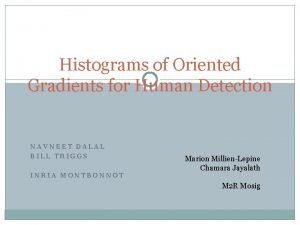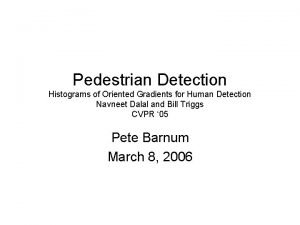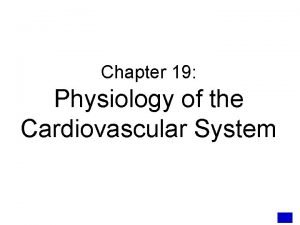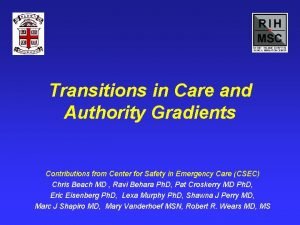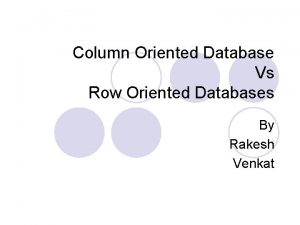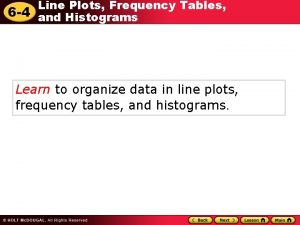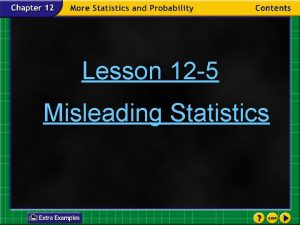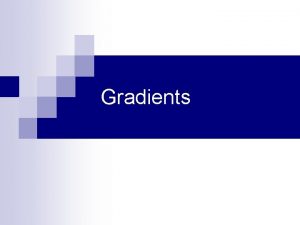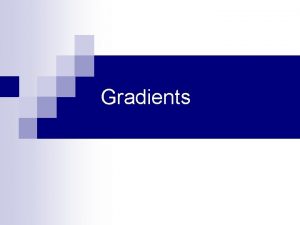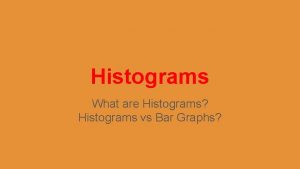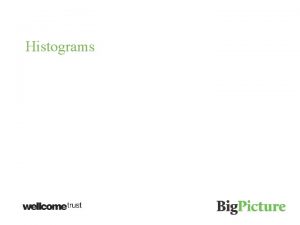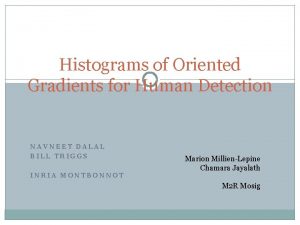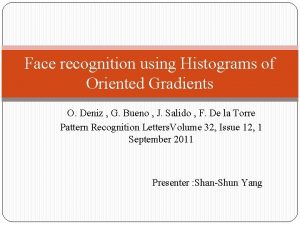Another Descriptor Histograms of Oriented Gradients for Human


![Details • Gradients [-1 0 1] and [-1 0 1]T were good enough. • Details • Gradients [-1 0 1] and [-1 0 1]T were good enough. •](https://slidetodoc.com/presentation_image_h2/581c05eec4a07c64dad09dffc0d3acbb/image-3.jpg)






- Slides: 9

Another Descriptor Histograms of Oriented Gradients for Human Detection Navneet Dalal and Bill Triggs CVPR 2005

Overview 1. Compute gradients in the region to be described 2. Put them in bins according to orientation 3. Group the cells into large blocks 4. Normalize each block 5. Train classifiers to decide if these are parts of a human
![Details Gradients 1 0 1 and 1 0 1T were good enough Details • Gradients [-1 0 1] and [-1 0 1]T were good enough. •](https://slidetodoc.com/presentation_image_h2/581c05eec4a07c64dad09dffc0d3acbb/image-3.jpg)
Details • Gradients [-1 0 1] and [-1 0 1]T were good enough. • Cell Histograms Each pixel within the cell casts a weighted vote for an orientation-based histogram channel based on the values found in the gradient computation. (9 channels worked) • Blocks Group the cells together into larger blocks, either R-HOG blocks (rectangular) or C-HOG blocks (circular).

More Details • Block Normalization They tried 4 different kinds of normalization. Let be the block to be normalized and e be a small constant.

R-HOG compared to SIFT Descriptor • R-HOG blocks appear quite similar to the SIFT descriptors. • But, R-HOG blocks are computed in dense grids at some single scale without orientation alignment. • SIFT descriptors are computed at sparse, scale-invariant key image points and are rotated to align orientation.

Standard HOG visualization shows orientations

Some guy named Juergen’s visualizations shows gradient vectors

Pictorial Example of HOG for Human Detection * (a) (b) (c) (d) (e) (f) (g) average gradient image over training examples each “pixel” shows max positive SVM weight in the block centered on that pixel same as (b) for negative SVM weights test image its R-HOG descriptor weighted by positive SVM weights R-HOG descriptor weighted by negative SVM weights

Gory Details from More Recent Work • A cell is of 8 x 8 pixels. A block is of 2 x 2 cells. • For each cell, construct a 9 -bin orientation histogram. • Contrast normalize each histogram using 4 adjacent/overlapping blocks, giving 36 numeric values for cell. • Total descriptor size depends on what template size you want. • If your template (say for a car) is 8 x 10 cells, the descriptor size would be 8 x 10 x 36 = 2880 values per window. • For whole images, they are typically resized to 100 x 100 pixels, discretized to 10 x 10 cells, so 10 x 36 = 3600 values. • Visualizations tend to plot only the first 9 dimensions of the 36 dimensions per cell. ---email from Santosh Divvala, postdoc
 Histogram of oriented gradients for human detection
Histogram of oriented gradients for human detection Histograms of oriented gradients for human detection
Histograms of oriented gradients for human detection Pressure gradients in the heart
Pressure gradients in the heart Steep authority gradient
Steep authority gradient Sales promotion vehicles
Sales promotion vehicles What is a column row db
What is a column row db The harp harris burdick
The harp harris burdick Frequency tables and histograms 14-5
Frequency tables and histograms 14-5 Misleading histograms
Misleading histograms Histogram worksheet with answers
Histogram worksheet with answers
